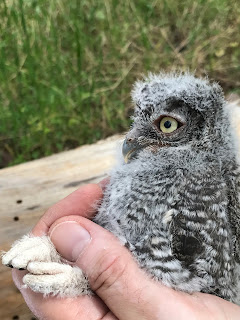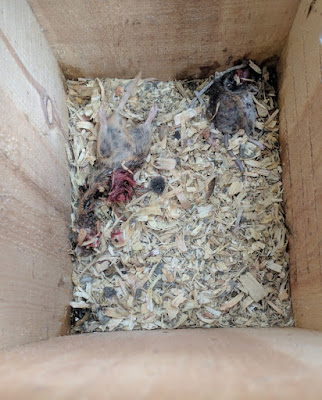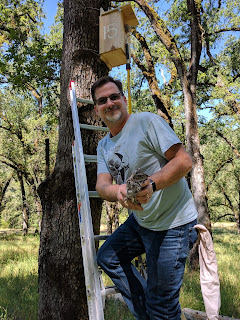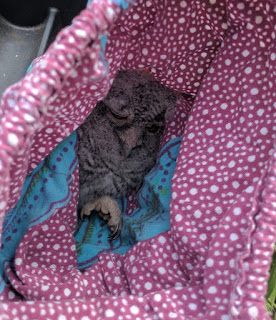 |
| #1! Lots of down but some contour feathers appearing |
 |
| #2 of the two owlets |
It was time to band the owlets after peeking into the box last week, I determined they were old enough, ~ 3 weeks to 1 month old and getting ready to "fledge." Typically owls leave the nest cavity and are called "branchers", because that's what they do, sometimes falling clumsily to the ground, climb up a tree, and perch on a branch. Their growing flight feathers are heavy with blood and they beg for food and begin to persistently follow their parents around before they are capable of even moderate flight. I wondered about this being a successful strategy because it seems safer remaining in a protected cavity. But after seeing and smelling the remains of this nest box, I think I figured out why it's best to get out of there (see below!)
 |
| At least 3 prey remains in this nestbox |
Here is more evidence of the male being a good provider with three different prey remains that might be a deer mouse, vole or gopher and the tiny remains of a pocket mouse or other tiny rodent.
 |
Ken climbs the ladder and hands me the mom for
weighing and checking the band we put on last week.
You can see the plug in the nest hole. |
We begin with Ken removing the female from the box (the nest hole is plugged to ensure she doesn't flush out of the nest) and handing her to me. She is held in a bag until the nestlings are banded. As typical for screech owls, she is very calm through this process.The female has a lot invested with two owlets, so would unlikely abandon a nest at this stage. Both owlets were plump at 135-145 grams (the same weight as some adult males). We banded and weighed them separately, so owlet #1 remained in the bag quietly waiting for the sibling.The mom was also well-fed, weighing in at 190 grams!
 |
| One owlet banded and held in a cloth bag until the second owlet is processed |
The owlets are returned to the nest box, then mom is returned. We wait about five minutes to remove the plug before leaving the owls safely in their box. I have no doubt the male is roosting somewhere nearby, but we were unable to find him.



